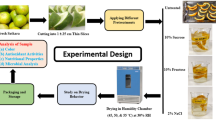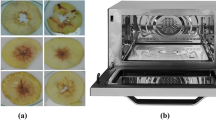Abstract
The aim of this study is to investigate the effects of drying temperatures and pretreatment on the physico-chemical, energy consumption and thermodynamic analyses of purple carrot slices drying processes. Slices were dried from 6.13 ± 0.05 g moisture.g dry matter moisture−1 value to 0.029 ± 0.001 g moisture.g dry matter−1 moisture value. The samples were dried in an oven at 50, 60, 70 and 80 °C at hybrid oven 350 W + 50 °C, 350 W + 60 °C, 350 W + 70 °C and 350 W + 80 °C. Among the models, the drying rates were best estimated by the Midilli–Küçük (R2: 0.9996) model. The effective diffusion values were between 1.30 × 10–7 and 1.27 × 10–6 m2 s−1, and the activation energy values were between 7.96 and 25.61 kJ mol−1. It has been determined that pretreatment and drying methods have different effects on the color values of the dried samples. While the highest energy consumption was determined in the drying process performed as 1.103 kWh, the least energy consumption was determined as 0.330 kWh. While the total evaporation energies of the control samples dried in the oven ranged between 14,039.20 and 14,231.70 kWh, the total evaporation energies of the pretreated samples were determined to vary between 14,175.50 and 14,352.00 kWh. It was determined that the total evaporation energies of the control samples dried in the hybrid oven varied between 14,143.30 and 14,360.10 kWh, while the evaporation energies of the pretreated samples varied between 14,197.50 and 14,234.60 kWh. Enthalpy (ΔH) values of drying processes were determined as 2601.67–2863.34 kJ mol−1, entropy (ΔS) values as 351.15–369.44 kJ mol−1 and Gibbs free energy (ΔG) values as 93,000.26–98,255.87 kJ mol−1.



Similar content being viewed by others
Availability of data
The data set used in the analysis of this study can be accessed from the author if deemed appropriate.
Abbreviations
- DR:
-
Dry rate
- MR:
-
Moisture ratio
- C:
-
Chroma
- SMER:
-
Specific moisture extraction rate
- SEC:
-
Specific energy consumption
- W:
-
Watt
- N k.b :
-
Moisture content relative to dry base = g moisture g dry base−1
- D eff :
-
Effective diffusion value = m2 s−1
- M i :
-
İnitial mass
- M l :
-
Last mass
- M t :
-
İnstant moisture content = g moisture.g dry base−1
- dt :
-
Minute
- M :
-
İnstant moisture content = g moisture.g dry base−1
- M e :
-
Equilibrium moisture content = g moisture.g dry base−1
- M o :
-
Initial moisture content = g moisture.g dry base−1
- k, h, j, m :
-
Constant coefficient
- t :
-
Time
- L :
-
Thickness value (m) of the product
- L*:
-
Brightness
- a*:
-
Redness
- b*:
-
Yellowness
- E t :
-
Total energy consumption
- m w :
-
Amount of removed moisture
- Q w :
-
Evaporation energy
- h fg :
-
Evaporation latent energy
- m w :
-
Amount evaporated moisture
- T d :
-
Dry temperature
- ∆H:
-
Enthalpy
- E a :
-
Activation energy
- ln kB:
-
Boltzmann constant
- ln hP :
-
Planck constant
- ∆S:
-
Entropy
- ∆G:
-
Gibbs free energy
- W x :
-
Uncertainty analysis
References
Alemrajabi AA, Rezaee F, Mirhosseini M, Esehaghbeygi A. Comparative evaluation of the effects of electrohydrodynamic, oven, and ambient air on carrot cylindrical slices during drying proces. Drying Technol. 2012;30:88–96. https://doi.org/10.1080/07373937.2011.608913.
Anonim, 2022. Havuç. https://tr.wikipedia.org/wiki/Havuç. (Erişim Tarihi: 09/06/2022).
Beigi M. Energy efficiency and moisture diffusivity of apple slices during convective drying. Food Sci Technol. 2016;36(1):150–4.
Boateng ID, Yang XM. Effect of different drying methods on product quality, bioactive and toxic components of Ginkgo biloba L. seed. J Sci Food Agric. 2020. https://doi.org/10.1002/jsfa.10958.
Corrêa PC, Oliveira GHH, Botelho FM, Goneli ALD, Carvalho FM. Modelagem matemática e determinação das propriedades termodinâmicas do café (Coffea arabica L.) durante o processo de secagem. Revista Ceres. 2010;57:595–601.
Corzo O, Bracho N, Alvarez Ve C. Water effective diffusion coefficient of mango slices at different maturity stages during air drying. J Food Eng. 2008;87(4):479–84.
Erenturk S, Erenturk K. Comparison of genetic algorithm and neural network approaches for the drying process of carrot. J Food Eng. 2007;78(3):905–12.
Ersus-Uyan S, Baysal T, Yurdagel Ü, El SN. Effects of drying process on antioxidant activity of purple carrots. Nahrung/Food. 2004;48(1):57–60.
FAO (2011). Energy-smart food for people and climate. 2/3/2017
FAO (2019). Food and Agriculture Organization of the United Nations. 05/04/2021.
Garba U, Kaur S. Effect of dryıng and pretreatment on anthocyanıns, flavenoıds and ascorbıc acıd content of black carrot (Daucus carrota L.). J Global Biosci. 2014;3(4):772–7.
Garba U, Kaur S, Gurumayum S, Rasane P. effect of hot water blanching time and drying temperature on the thin layer drying kinetics of and anthocyanin degradation in black carrot (Daucus carota L.) shreds. Food Technol Biotechnol. 2015;53(3):324–30.
Guimarães RM, Oliveira DEC, Resende O, Silva JS, Rezende TAM, Egea MB. hermodynamic properties and drying kinetics of ‘okara.’ Revista Brasileira de Engenharia Agrícola e Ambiental. 2018;22(6):418–23.
Jena S, Das H. Modeling for vacuum drying characteristics of coconut presscake. J Food Eng. 2007;79:92–9.
Jha A, Tripathy PP. Clean energy technologies for sustainable food security. Water-Food-Energy Nexus Process Technol Chall. 2017;1:197–219. https://doi.org/10.4324/9781315153209.
Jha A, Tripathy PP. Recent advancements in design, application, and simulation studies of hybrid solar drying technology. Food Eng Rev. 2021;13:375–410. https://doi.org/10.1007/s12393-020-09223-2.
Jideani VA, Mpotokwana SM. Modeling of water absorption of Botswana bambara varieties using Peleg’s equation. J Food Eng. 2009;92(2):182–8.
Keskin M, Güçlü G, Şekerli YE, Soysal Y, Selli S, Kelebek H. Comparative assessment of volatile and phenolic profiles of fresh black carrot (Daucus carota L.) and powders prepared by three drying methods. Sci Hortic. 2021. https://doi.org/10.1016/j.scienta.2021.110256.
Kumar C, Millar GJ, Karim MA. Effective diffusivity and evaporative cooling in convective drying of food material. Dry Technol. 2015;33(2):227–37. https://doi.org/10.1080/07373937.2014.947512.
Kumar P, Thakur N, Sharma K, Thakur HA. Effect of different pre-treatments on quality of carrot roundels. J Pharmacogn Phytochem. 2018;7(3):3086–92.
Lewicki, P. P. Das, Gupta, D. K. (1995). Osmotic dehydration of fruits and vegetables in handbook of industrial drying, Vol. 1, 2nd Edition, Ed. A.S. Mujumdar, Marcel Dekker, New York, pp. 691–713.
Madlool NA, Saidur R, Hossain MS, Rahim NA. A critical review on energy use and savings in the cement industries. Renew Sustain Energy Rev. 2011;15(4):2042–60.
Midilli A, Küçük H, Yapar Z. A new model for single-layer drying. Dry Technol. 2002;20(7):1503–13.
Moffat RJ. Describing the uncertainties in experimental results. Exp Thermal Fluid Sci. 1988;1(1):3–17.
Morais RMSC, Morais AMMB, Dammak I, Bonilla J, Sobral PJA, Laguerre JC, Afonso MJ, Ramalhosa ECD. Functional dehydrated foods for health preservation. J Food Qual. 2018. https://doi.org/10.1155/2018/1739636.
Moses JA, Norton T, Alagusundaram K, Tiwari BK. Novel drying techniques for the food industry. Food Eng Rev. 2014;6:43–55.
Motevali A, Abbaszadeh A, Minaei S, Khoshtaghaza MH, Ghobadian B. Effective moisture diffusivity, activation energy and energy consumption in thin-layer drying of jujube (Zizyphus jujube Mill). J Agric Sci Technol. 2012;14(3):523–32.
Mujumdar AS, Law CL. Drying technology: trends and applications in postharvest processing Food. Bioprocess Technol. 2010;3:843–52.
Pixton SW, Warburton S. Determination of moisture content and equilibrium relative humidity of dried fruit-Sultanas. J Stored Prod Res. 1973;8(4):263–70.
Polat S, Güçlü G, Kelebek H, Keskin M, Selli S. Comparative elucidation of colour, volatile and phenolic profiles of black carrot (Daucus carota L.) pomace and powders prepared by five different drying methods. Food Chem. 2022. https://doi.org/10.1016/j.foodchem.2021.130941.
Purohit P, Kumar A, Kandpal TC. Solar drying vs. open sun drying: a framework for financial evaluation. Sol Energy. 2006;80(12):1568–79. https://doi.org/10.1016/j.solener.2005.12.009.
Ramallo LA, ve Mascheroni RH. Quality evoluation of pineapple fruit during drying process. Food Bioprod Process. 2012;99:275–83.
Resende O, Oliveria DEC, Chaves TH, Ferreira J, Bessa V. Kinetics and thermodynamic properties of the drying process of sorghum (Sorghum bicolor [L.] Moench) grains. Afr J Agric Res. 2014;9(32):2453–62.
Santos KC, Guedes JS, Rojas ML, Carvalho GR, Augusto PED. Enhancing carrot convective drying by combining ethanol and ultrasound as pre-treatments: effect on product structure, quality, energy consumption, drying and rehydration kinetics. Ultrason Sonochem. 2021. https://doi.org/10.1016/j.ultsonch.2020.105304.
Sharma A, Chen CR, Lan NV. Solar-energy drying systems: a review. Renew Sustain Energy Rev. 2009;13(6–7):1185–210. https://doi.org/10.1016/j.rser.2008.08.015.
Soomro AH, Miano TF, Marri A, Kuamr D, Khaskheli SG, Arain UF, Baloch AB. Application of pretreatments on banana slices for improving drying characteristics. Food Sci Qual. 2020;103:35–41.
Sucheta, Misra NN, Yadav SK. Extraction of pectin from black carrot pomace using intermittent microwave, ultrasound and conventional heating: kinetics, characterization and process economics. Food Hydrocolloids, 2020; doi: doi:https://doi.org/10.1016/j.foodhyd.2019.105592.
Surendhar A, Sivasubramanian V, Vidhyeswari D, Deepanraj B. Energy and exergy analysis, drying kinetics, modeling and quality parameters of microwave-dried turmeric slices. J Therm Anal Calorim. 2019;136:185–97.
Tan M, Chua KJ, Mujumdar AS, Chou SK. Effect of osmotic pre-treatment and infrared radiation of drying rate and color changes during drying of potato and pineapple. Dry Technol. 2001;19(9):2193–207.
Taşkın O, İzli G, İzli N. Physicochemical and morphological properties of European cranberrybush powder manufactured by freeze drying. Int J Fruit Sci. 2021;21(1):1008–17. https://doi.org/10.1080/15538362.2021.1971141.
Tuna T, Sönmez İ, Beşirli G, Alan AR, Çelebi-Toprak F, Şeker M. Yalova havuç (Daucus carota L.) gen havuzunda bulunan genotiplerin bazı morfolojik özellikleri. Bahçe. 2021;50(1):35–42.
TÜİK, 2020. Türkiye İstatistik Kurumu. 05/04/2020.
Uribe E, Gómez-Pérez LS, Pasten A, Pardo C, Puente L, Vega-Galvez A. Assessment of refractive window drying of physalis (Physalis peruviana L.) puree at different temperatures: drying kinetic prediction and retention of bioactive components. J Food Meas Charact. 2022. https://doi.org/10.1007/s11694-022-01373-7.
Yağcıoglu A. Tarımsal Ürünleri Kurutma Tekniği. Ege Üniversitesi Ziraat Fakültesi Yayınları No: 536. Bornova, İzmir; 1999.
Yan JK, Wu LX, Qiao ZR, Cai WD, Ma HL. Effect of different drying methods on the product quality and bioactive polysaccharides of bitter gourd (Momordica charantia L.) slices. Food Chem. 2019;271:588–96.
Acknowledgements
The authors are grateful to Dr. Mehmet Zahid Malaslı for his critical reading and through syntactic corrections of the manuscript. This work has not received any funding.
Author information
Authors and Affiliations
Contributions
MT contributed to maintaining laboratory studies, processing all data and writing articles. MZM was involved in technical and spelling checking of the article. SKD assisted in maintaining laboratory studies and processing all data.
Corresponding author
Ethics declarations
Conflict of interest
There is no conflict of interest between the authors.
Additional information
Publisher's Note
Springer Nature remains neutral with regard to jurisdictional claims in published maps and institutional affiliations.
Rights and permissions
Springer Nature or its licensor (e.g. a society or other partner) holds exclusive rights to this article under a publishing agreement with the author(s) or other rightsholder(s); author self-archiving of the accepted manuscript version of this article is solely governed by the terms of such publishing agreement and applicable law.
About this article
Cite this article
Taşova, M., Malaslı, M.Z. & Dursun, S.K. The effect of drying methods and pretreatment on physico-chemical, energy consumption and thermodynamic analysis of “Hatay” genotype purple carrot slices. J Therm Anal Calorim 148, 12711–12723 (2023). https://doi.org/10.1007/s10973-023-12576-5
Received:
Accepted:
Published:
Issue Date:
DOI: https://doi.org/10.1007/s10973-023-12576-5




